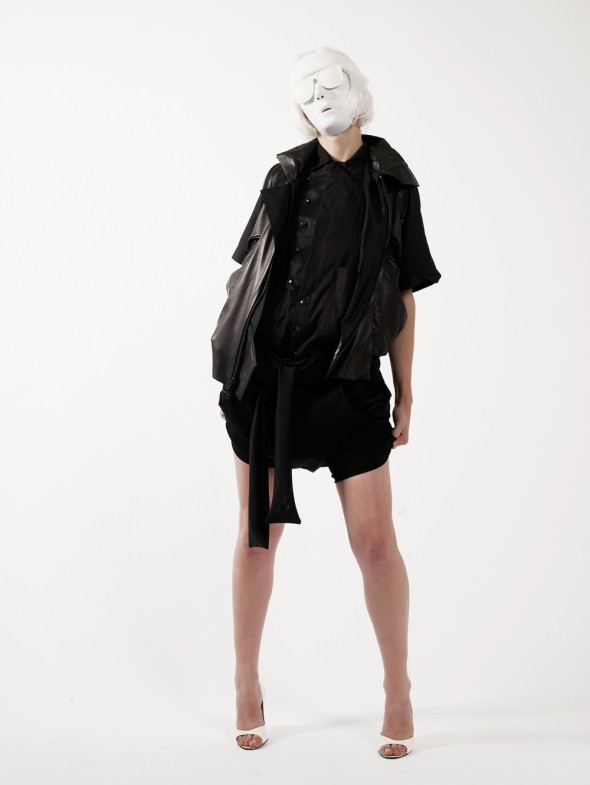
Photography by Richard Krupp/ Courtesy of Bland
Dada Punkist Ted Willoughby colors the world of fashion in hues of conceptual perversion and pantomime
For lack of a better descriptor, we’ll call Bland a “clothing line”— though that hardly encapsulates the cleverly subversive efforts of Theodoric Bland Willoughby and his co-conspirator Meghan Coleman that have included, among other things, hooded hats, cigarette broaches, armless vests, clear ruler sunglasses, mannequin pantomime, as well as some expertly constructed unisex separates. It’s a slightly absurdist approach to fashion that dispenses with those tedious and largely outmoded demarcations between fashion and art — all with a good dose of street sass thrown in. “I like the description ‘Dada Punkist’ that Jefferson Hack called the last show,” says Willoughby (yup, that’s his real name) from his Mott Street atelier. “It sounded really cool. Now I think I want to be one.”
As a charter member of the Deitch Projects tribe, this should be no problem. But then again, art is more than a handy-dandy reference for the line; it serves both as its founding ethic and vital point of departure: “Ideally, I’d like to think of the Bland ‘endeavor’ as a really twisted show you’d see at a gallery,” he muses. “And the clothes and accessories are items available at an amazing gift shop on the way out.” For Spring 2009, this twisted vision came to life with a debut presentation staged at Deitch Projects’ Grand Street space (with the enviable backdrop of Tauba Auerbach’s latest batch of paintings). The fashion show-cum-performance piece featured a bold offering of architectural silhouettes and techno fabrics, largely inspired by old skool art power dressing (think ’80s gallerist, or better yet, Catherine O’Hara in Beetlejuice — all black and shapes). A bit obscure, a bit macabre, but that’s how Bland rolls. “The concept for the show was kind of an illegitimate daughters of Charles Ray as mannequins,” he adds by way of explanation, “with one mannequin that was a dancer who would come to life occasionally and have an interpretive dance or two around the gallery.”
Weird? Yes. But decidedly so — and it’s precisely this type of thinking that’s making Bland anything but in the doldrums of tent dresses and respectable basics that’s become the New York fashion circuit. It makes one itch for some conceptual perversion and a bit of pantomime to boot, and Willoughby is all too happy to oblige. Of course, it helps that his take on style has been anything but straight ‘n’ narrow. The Texas-born, dc-raised designer has fostered a somewhat petulant relation to clothes. “Fashion design was sort of a challenge I set for myself,” he ruminates. Indeed, far from fulfilling secret Devil Wears Prada fantasies, the 28-year-old Parsons grad took up needle and thread simply as an alternate medium for his artistic experimentation: “When I went to art school I wanted to be a painter, but I realized I couldn’t fathom the idea of someone teaching me how to paint. I thought if I studied fashion, it would teach me brand new skills and a craft I wouldn’t learn any other way.”
The result is something like “fashion-as-ready made,” which may be as good a way as any of describing his first splash: a series of playfully menacing (or is it menacingly playful?) hats. “I made them from bandanas and fabrics found at American discount chain stores. They were conceived as a sort of prop for a project with little kids and Molotov cocktails and the implied jingoistic identity issues. But you can’t sell disturbing shit like that, so it was the best choice to leave those kind of things on the back burner and work on just making really nice clothes and leave the really twisted ideas to myself.”
And nice clothes they surely are. Despite the heavy jargon and art world cred, Bland is ultimately about cool clothes for cool folks and there’s nothing wrong with that. Upon closer inspection, his handiwork reveals a myriad of minute details: nylon meshing used as internal construction, utilitarian belts twisted into dashing ornaments, meanly tailored bustiers that are decidedly not unisex. If this is madness, it’s of the rapturous but methodical kind: “I like the punk idea that you could wear an expensive dress twice a week and throw it on the ground behind the laundry hamper, then shake it off, steam it while you take a shower to go out, and it looks like a million bucks. The construction is paramount to any garment.”
Construction was paramount to the Fall ’09 collection but for slightly more sinister reasons. Returning to Spring’s mannequin theme, the result was less mime convention, more lost reels from Silence of the Lambs. Playing out like the fashion week fantasy of Jame Gumb, aka Jack Gordon, aka Buffalo Bill, the sophmore effort flirted with a harder-edged take on fashion, replete with studding, corsetry, rivets and hardware. This effect was brought full force when descending into the cavernous basement of Terence Koh’s Asia Song Society, which hosted the event, and which (needless to say) has witnessed enough pagan debauchery to rival the best slasher flicks. “The space has so much character and a twinge of evil perversion,” he notes, with a slight tone of glee. “From the black dungeon and the flourescent lights upstairs, I think that came out a lot with the mannequin parts and the evil movie in the basement. But after the show we sold all but one of the mannequins and thus retired our Disturbing Mannequin Aesthetic (dma) for the meantime.”
— Franklin Melendez

